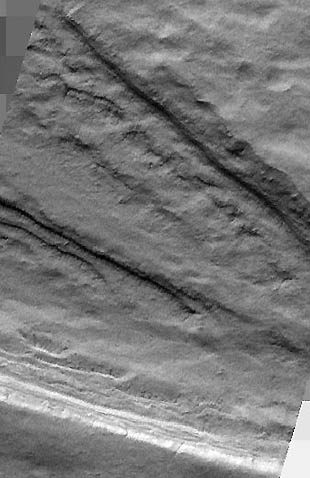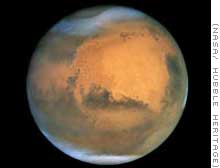
January 5, 2003 Boulder, Colorado – Both the north and south polar caps of Mars have large areas where ice and dust have been deposited over time in layers several kilometers deep. Carbon dioxide hoar frost freezes out of the atmosphere in the polar winter on the surface. But ten meters below the surface, it’s almost exclusively water ice. In the Martian south pole, the icy layered deposits cover an area much bigger than the actual polar cap.
When the first Viking spacecraft flew around Mars in 1976, its photographs faintly show mysterious grooves across some of the south pole ice. Modern images from the Mars Global Surveyor show the long, sweeping grooves are at least 200 kilometers long and 80 to 100 kilometers wide.
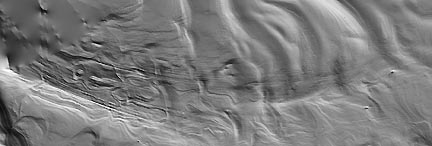
So far, no one knows what is creating the long, parallel grooves in the south polar ice. One scientist who has been studying them presented a paper with photographs at the recent American Geophysical Union meeting in San Francisco. He is Zane Crawford, a Ph.D. candidate in Geological Sciences at the University of Colorado, Boulder. In 1998, he received his B. S. in Engineering and Applied Science from California Institute of Technology in Pasadena. This week I asked him why the grooves are mysterious.
Interview:
Zane Crawford, Ph.D. Candidate, Geological Sciences, University of Colorado, Boulder, Colorado: “The grooves are very shallow and they are almost perfectly in line with each other, but they don’t seem to pay much attention to the surrounding topography. When people first saw them, they thought maybe it was an error in the data. These are topographical grooves, so there are rises and falls of grooves in the mounds of the icy deposits.
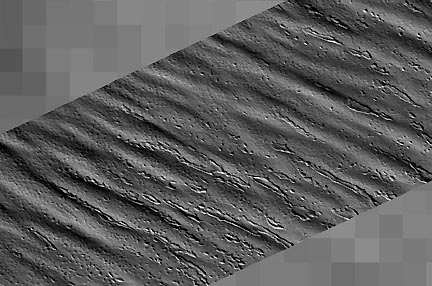
But it turns out they really are there, and as we got more and more data, they became more and more clear. Nobody really has a good idea of what kind of things would cause that because we haven’t seen that kind of feature on Earth and most of the geophysics we’ve done on other planets is by analogy to things we have seen on Earth.
WHAT ARE THE BEST SPECULATIONS?
The two hypotheses that we’ve considered:
1) Glacial flows so an ice material flowing by gravity over the surface of the layered deposits like you would get in the polar regions here on Earth or ice streams in Antarctica.
But there are problems with that.
2) The other hypothesis is that they are wind features, Aeolian erosion, polar winds coming down off the south polar cap headed toward the lower areas around the layered deposits and eroding as they go along.
Could the Grooves Be Carved by Glacier Movement at the Martian South Pole?
On Earth, glaciers usually flow on top of rocks or on other non-ice substrates. But this would have to be a glacier flowing on top of something else that is mostly ice, which seems pretty strange. The reasons glaciers flow across rocks on Earth is because of gravity, usually going down hill. But these south polar cap grooves on Mars really don’t go down hill. They are almost perfectly flat. Then at the edge of the layered deposits, there is a steep drop off, but we don’t see that they go all the way to that steep drop off. And also, grooves underneath glaciers on Earth are formed because rocks and boulders and other debris are being dragged along beneath the ice. But on Mars on these layered deposits, there are no rocks other than meteorites, and there aren’t many of them. So, it’s not clear what would cause grooves underneath the glacier.
And the temperatures are so low that ice there is as hard as concrete. It doesn’t deform like ice would here on Earth. Warmer ice is softer than colder ice, so warmer ice flows more smoothly than colder ice.
HOW FLAT IS THE GROOVED REGION?
Very flat. It only goes down less than 1 degree of inclination. So, if you were going up a well-graded mountain road, that would be much steeper than the slope that these grooves are going down. If you were walking across the surface, you might not even see the grooves. The only reason that we can see them is because of the sensitivity of the laser altimeter on the Mars Global Surveyor spacecraft.
MEASURING THE CHANGES IN THE ALTITUDE OF VARIOUS FEATURES WITH A LASER THAT IS ATTACHED TO THE GLOBAL SURVEYOR.
Yes. It gives you basically a topographic map. It tells you where it is high and low.
IF IT IS THIS FLAT, THEN THE HYPOTHESIS OF ANY GLACIATION JUST DOESN’T SEEM TO MAKE ANY SENSE, DOES IT?
No, not really. On ice caps like Greenland or Antarctica, you get flow even if it is flat you get flow because ice and snow is being deposited in the center and it’s breaking away at the edges where it’s connected to the oceans. But there is no evidence that there has been any kind of ocean – -at least in the southern portion of Mars. So, glacial flow, we would not expect to see in the southern polar regions on top of these layered deposits.
Could High Velocity Winds Be Carving Grooves into the Martian South Pole?
Wind if it’s a wind feature, then you would expect the wind to deflect around obstacles in its path to kind of follow the topography, but it doesn’t really seem to do that on the grooves. They just seem to go straight over what ever is underneath them. The curvature of the grooves, as they go away from the south pole, they curve a bit to the west, which is what you would expect from a wind coming away from a pole on Earth and on Mars and other planets because the planet is spinning as the wind moves away from the pole to keep its linear speed the same, it has to change direction. That is called the Coriolis force and it’s why a lot of the weather patterns we have on Earth exist, the large scale weather patterns.
To get this curvature, you would have to have very high speed winds, over 60 to 80 meters per second which is not crazy. There are winds that fast. We’ve seen evidence of them on Mars. But it’s kind of at the upper limits of feasibility.
HOW COULD FAST WINDS CARVE PERFECTLY PARALLEL TRACKS THAT ARE 200 KILOMETERS LONG?
This would have to be a wind that is going in the same direction for hundreds of kilometers without really turning at all, which seems very strange. That’s not the kind of thing you would generally see on Earth. If it were just a perfectly spherical body with nothing operating on it except the Coriolis force, you might see that. But there is topography underneath there, beneath the wind. The polar caps undulate and there is a big scarp at the end of them and kind of downhill overall. The winds are cutting across a gentle slope which if it were winds going down hill, you would expect it to just go down hill, not across the hill.
So, both of these hypotheses have pretty serious problems. The truth is we don’t really know what causes these grooves.
Could Non-Human Intelligences Be Mining Ice at the Martian South Pole?
WHAT ABOUT SOME OTHER INTELLIGENCE IN THE UNIVERSE OR THE SOLAR SYSTEM THAT IS MINING SOMETHING FROM THE ICE?
That’s certainly a possible hypothesis, but I don’t think anyone would fall back on that until really all possible simple geological explanations had been exhausted. There is nothing here that really seems to imply anything as complex as another intelligence or life of any kind. It’s overall a very simple feature.
BUT VERY MYSTERIOUS.
But very mysterious, yes. There is no hypothesis that seems to fit all the data we have about them. But there is a lot of geology even here on Earth that we don’t fully understand.
Could the Grooves Be Caused by Liquid Water Flowing at the Martian South Pole?
If you look further up toward the polar cap and there is not very much good data for right around the south Martian pole because of the orbit the Mars Global Surveyor is in. But in some of the old Viking pictures, you can see features that almost look alluvial, very sinuous river and channel flow, and some people have speculated that it might be a liquid outflow over the surface of the ice. Some spring being heated underneath the ice that breaks through the surface occasionally. This happens in Iceland where they have both glaciers and volcanoes. But it’s not the kind of erosion you usually see from liquid flow. To get the polar caps of Mars warm enough that you would have liquid water flowing over their surfaces, you would really have to do spectacular things to the Martian climate that would probably destroy the polar caps altogether. But they clearly exist.
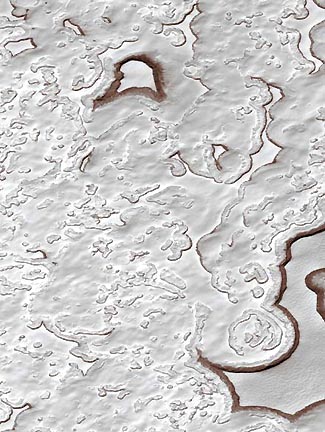
Could A Change in the Sun Be Causing Global Warming on Mars?
IS THERE ANY DATA THAT MARS IS WARMING UP INCREMENTALLY AS WE ARE SEEING ON THE EARTH THAT IS ATTRIBUTED TO GLOBAL WARMING FROM CARBON DIOXIDE HERE. WHAT ABOUT MARS?
Interestingly, Mike Malin of Malin Space Sciences, have detected changes in the carbon dioxide veneer of the south polar cap which seem to change from year to year. It’s not just that there are seasonal changes, but that from the first Martian year that the spacecraft observed to the second Martian year that the spacecraft observed, there was an overall loss of carbon dioxide ice. So, over the past couple of years at least, there has been a warming of the south Martian polar regions.
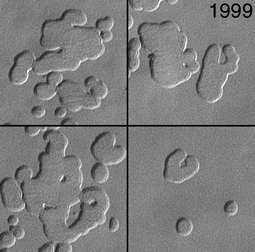

Mars Global Surveyor’s orbiter camera (MOC) photographed changes in the Martian
south polar cap, indicating recent climate change on Mars (MOC2-297, December 6, 2001).
Photograph courtesy JPL and Malin Space Science Systems.
DOES ANYBODY LINK THAT TO CHANGES IN OUR SUN?
People have definitely speculated that it might be because of solar activity and maybe it’s possible that the warming that Mars seems to be experiencing is the same as the warming that the Earth seems to be experiencing. But we don’t have enough data about the Martian climate and how it changes over time to be sure. It might be a multi-year cycle that Mars undergoes where dust and ice accumulates, then sublimates away. It might be because of an obliquity change that Mars has undergone and its tilt has changed and so it” having more severe seasonal changes, hotter summers, colder winters. That overall would lead to a loss of ices and volatiles from the polar regions.
The Martian climate has changed much more dramatically in the past than Earth’s, it appears. So, it might be just one of the Martian fluctuations. Or, it could be because of changes in the sun.
HAS DR. MIKE MALIN GOTTEN ANY PHOTOGRAPHS PRIOR TO THE ONES YOU HAVE BEEN STUDYING OF THIS SOUTH POLE REGION FOR COMPARISON?
Prior photographs of the grooves?
YES.
Well, pretty much all of the pictures I’ve looked at, except for a couple of Viking images, have been from the Mars Orbital Camera which Malin built.
SPANNING HOW MANY YEARS?
Spanning a little more than 2 Martian years, which is around 4 Earth years.
SO NO MORE DATA FROM THE SOUTH POLES ON THESE GROOVE AREAS PRIOR TO ABOUT 4 YEARS AGO?
You can see them faintly in a couple of Viking images from the 1970s. But other than that, it’s all come from Mars Global Surveyor. We’re hoping to get new information from the Mars Odyssey Spacecraft which just arrived last year.
Mars Odyssey Spacecraft Upcoming Photographs Might Help Answer the Mystery
WHEN WOULD THOSE IMAGES START COMING BACK?
We’ve gotten some Mars Odyssey pictures from the south pole, but it’s not a very high priority observation because they are trying to pick good landing sites for the mission that is going out later this year. But once they’ve done observations that are critical for future landing missions, they will start taking suggestions for pictures from the general Mars science community and we’re hoping we’ll get better coverage.
The resolution of the Mars Odyssey Camera is not as good as the MOC narrow angle. But we’ll get much fuller coverage. So, right now, we’ve got pictures here and there of various things, but there are a lot of gaps in between. It will be nice to be able to fill in those gaps.
WHEN WOULD YOU NEXT EXPECT TO GET PHOTOGRAPHS OF THE SOUTH POLE?
I would guess there will be significant numbers of pictures from the polar regions within the next year, just because the polar regions are very well covered compared to the rest of the planet because the spacecraft are in near polar orbits. They go over the poles every time they make an orbit and their tracks are very near together at the poles and very spread out near the equator. So, we expect to get pretty much full coverage of the poles eventually from the Odyssey spacecraft. I think the resolution is about 20 meters per pixel.
DO YOU THINK THAT WOULD SOLVE THE MYSTERY OF THE GROOVES AT THE SOUTH POLE?
I think it will definitely give us a better chance at solving it.
Beyond Ice Groove Mysteries, Where Did All the Ancient Martian Water Go?
The greatest mystery on Mars right now is: where did the water go? And why did it go there? Mars has a very extreme hydrological history. There is a lot of watery features from early in its history. The great Valles Marineris and outflow channels, the northern plains that look to some like they could have been the floor of an ancient Martian ocean. But today, the Martian atmosphere is almost completely devoid of water. You’ve got small polar caps and apparently a lot of permafrost trapped near the poles underneath the surface. But it’s a huge change in the Martian climate that is a little bit scary that planets can change that much. It would be very interesting to know how quickly it changed and what exactly it was that was driving the change.
BECAUSE THE SAME THING MIGHT HAPPEN HERE?
Yes, the same kind of thing could happen here. It would be nice to have a general idea of how climates change over time, of the changes that can happen to planets and the kinds of things that can effect a global climate so we can be more careful with our own climate if it comes to the point we have the power to influence it significantly.
IS IT STILL THOUGHT POSSIBLE THAT ALL OF THE WATER THAT MIGHT HAVE BEEN ON THE SURFACE OF MARS A COUPLE OF BILLION YEARS AGO COULD STILL BE TRAPPED INSIDE OF THE LAYERS OF THE MARTIAN SOIL FOR REASONS THAT ARE NOT KNOWN, BUT COULD ALL THE WATER STILL BE THERE?
Well, we know that Mars has lost at least some water. It doesn’t have everything it started with because of the deuterium to hydrogen ratio of the water that still exists in the atmosphere.
There are two different kinds of hydrogen, which is one of the atoms that makes up water. There is hydrogen and deuterium. Hydrogen has one proton in its nucleus. Deuterium has a proton and a neutron. So, deuterium is about twice as massive. One of the ways that planets can lose water or other volatiles or gases from their atmospheres is by something called thermal escape. At the very top layer of the atmosphere, there aren’t a lot of molecules. So, as they bounce around because they are warm, sometimes they will bounce away from the planet and just happen to never hit another molecule and bounce back. If they are going fast enough, they will be lost from the planet forever. They don’t come back. This is easier for a light atom like hydrogen, and harder for something heavier like deuterium. So over time, you tend to lose more hydrogen than deuterium.
We know about what the ratio was that it started with. We assume it’s pretty close to the ratio that Earth had. So, we look at the ratio in the atmosphere today and we see an excess of deuterium. There is too much left over deuterium for the amount of hydrogen there is. So we assume that it has lost some of its complement of hydrogen. The most common molecule on Mars that would have hydrogen in it is water. So, we assume that it has lost a lot of water.
COULD THAT HAVE HAPPENED BY THE IMPACT OF SOMETHING LIKE AN ASTEROID OR PLANET HITTING THE PLANET?
If you were losing atmosphere because of an impactor, you would expect that you would lose about the same amounts of deuterium and hydrogen. The processes that lose hydrogen preferentially tend to be very slow, gradual processes that operate over hundreds of millions of years.
WHAT IF THERE WERE A STRONG IMPACT THAT ACTUALLY EJECTED WATER ALONG WITH GASES AWAY FROM MARS?
We expect this kind of thing has happened in the past. It’s called impact erosion, you’re eroding the atmosphere away. But you would be losing mostly bulk chunks of the atmosphere, which is well mixed. You would be losing both at the same time, hydrogen and deuterium.
YOU ARE SAYING THAT THE AMOUNT OF DEUTERIUM YOU HAVE BEEN ABLE TO MEASURE IN THE UPPER ATMOSPHERE INDICATES THAT THERE WOULD HAVE BEEN MORE WATER BEFORE?
Yes, more water. More water. Venus has undergone the same kind of process. But it’s lost virtually all of its water. It has a huge deuterium to hydrogen ratio, whereas the amount of deuterium in the atmosphere on Mars is much closer to that of the Earth’s.
VENUS, EARTH AND MARS AT SOME TIME IN THE SOLAR SYSTEM ALL HAD WATER?
Yes, we think that rocky planets like the terrestrial planets that are close to the sun in our solar system, are born with a fairly large complement of water.
BORN WITH, WHAT DOES THAT MEAN?
When they form out of the nebula of gas and dust that collect around a star when it’s forming, some of that gas is water vapor and a lot of minerals can take up a significant amount of water. In their solid form, you’ve got water not really dissolved in, but taken up in the mineral structure. Then over time as it heats on a large planet, that water and other volatiles like carbon dioxide can be out-gased and that’s a lot of where we think the Earth’s atmosphere came from, from out-gasing of volatiles trapped within its interior.
WHAT IS THE CURRENT BEST SCIENTIFIC GUESS ABOUT WHAT MIGHT HAVE HAPPENED TO ALL THE WATER ON MARS?
We know it’s lost water from thermal escape. We suspect it’s lost water from impact erosion, from big impacts splattering off bits of its atmosphere. the water it has today is trapped as ice near the polar regions. there is also sputtering which is a process in which almost any constituent, molecule in the atmosphere, can be lost. this is a problem on Mars because it does not have a magnetic field like the Earth does. So, the charged particles streaming off of the sun that we call the solar wind make it all the way to the top of the atmosphere and can strip off whatever is near the top over time. The Earth is protected by a magnetic field. Charged particles don’t like to cross magnetic field lines. So, they never make it to the top of our atmosphere, except sometimes near the poles where they follow the lines down to the surface and that’s what causes the aurora borealis, the Northern Lights.
There are all these processes that have taken place, but we don’t really know which ones have been more important and what portion of the water has been lost because of each one.”
More Information:
See: Earthfiles July 1, 2002 – Scientists Surprised by Abundance of Water Ice on Mars
Future Mars Missions
2003 – Mars Express
 Launches June 2003 to arrive Mars in December 2003. NASA is participating with the European Space Agency and Italian space Agency to explore the atmosphere and surface of Mars from polar orbit. The mission’s main objective is to search for sub-surface water from orbit and deliver a lander to the Martian surface. The lander is called Beagle 2 after the ship in which Charles Darwin set sail to explore the earth in 1831. After landing, Beagle 2 will perform exobiology and geochemistry research, while seven instruments onboard the orbiting Mars Express will study the Martian atmosphere and its geology.
Launches June 2003 to arrive Mars in December 2003. NASA is participating with the European Space Agency and Italian space Agency to explore the atmosphere and surface of Mars from polar orbit. The mission’s main objective is to search for sub-surface water from orbit and deliver a lander to the Martian surface. The lander is called Beagle 2 after the ship in which Charles Darwin set sail to explore the earth in 1831. After landing, Beagle 2 will perform exobiology and geochemistry research, while seven instruments onboard the orbiting Mars Express will study the Martian atmosphere and its geology.
2003 – Mars Exploration Rover Mission
 Launches May-July 2003 to arrive Mars in January 2004. Two identical, sophisticated mechanical robots will land in different regions of Mars. Each will be able to move up to 100 meters (110 yards) on the surface in each Martian day. The robots will search for liquid water and rocks and soils will be analyzed by a set of five instruments in each rover. Surface research is expected to last until late May 2004, or longer.
Launches May-July 2003 to arrive Mars in January 2004. Two identical, sophisticated mechanical robots will land in different regions of Mars. Each will be able to move up to 100 meters (110 yards) on the surface in each Martian day. The robots will search for liquid water and rocks and soils will be analyzed by a set of five instruments in each rover. Surface research is expected to last until late May 2004, or longer.
2005 – Mars Reconnaissance Orbiter
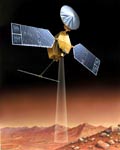 This mission will also focus on analyzing the Martian surface for water and measure the landscapes at 20-to-30-centimeters, or 8-to-12-inches resolution, good enough to see rocks the size of beach balls.
This mission will also focus on analyzing the Martian surface for water and measure the landscapes at 20-to-30-centimeters, or 8-to-12-inches resolution, good enough to see rocks the size of beach balls.
2009 – Smart Lander and Long-range Rover
 NASA hopes to launch this roving, mobile science laboratory as early as 2009. The goal is to also make the lander “smart” so it can land exactly where guided and avoid any hazards on the way down by sensing them.
NASA hopes to launch this roving, mobile science laboratory as early as 2009. The goal is to also make the lander “smart” so it can land exactly where guided and avoid any hazards on the way down by sensing them.
Websites:
http://solarsystem.nasa.gov/whatsnew/images-mod.html
http://mars.jpl.nasa.gov/gallery/polaricecaps/co2_cover_100.html
http://mars.jpl.nasa.gov/missions/index.html
© 1998 - 2025 by Linda Moulton Howe.
All Rights Reserved.



